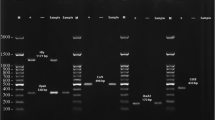Abstract
Urinary tract infection (UTI) with E. coli (UPEC) is one of the most common bacterial infections among human beings. In addition to the host predisposing factors, genes are also proposed to have an important role in the occurrence of UTIs. This study investigated the distribution of three pathogenic genes including aggR, aap and aatA among UPEC infected samples and their linkage with stbA, the essential gene for maintaining of pAA plasmid. A total of 244 samples were collected from patients with UTIs through clinical laboratories located in western side of Tehran (Iran) during years 2008–2009. E. coli isolation was performed according to standard laboratory methods. DNAs were extracted from samples using Boiling method, and the presence of aap, aggR, aatA and stbA genes were investigated by PCR. No pathogenic genes (aap, aggR, aatA) were found in 104 out of 244 UPEC samples, while 14 of them were carrying stbA gene. Out of 140 UPEC samples with pathogenic genes, 94 (46.6%) were carrying aap gene, 52 (23%) aggR gene, and 80 (35.4%) aatA gene. A total of 18 samples were also carrying all pathogenic genes together. Moreover, 44 out of 144 samples were carrying stbA gene. The results obtained by this study showed that the aggR, aap and aatA pathogenic genes have different existence patterns in different E. coli strains that infect different organs. Our study also showed that these three plasmid genes in EAEC strains are able to transpose in the genome and change their level of linkage with pAA plasmid essential gene stbA. Meanwhile, this study confirmed that aggR, aap and aatA genes are not specific to only EAEC strains.


Similar content being viewed by others
References
Abe CM, Salvador FA, Falsetti IN, Vieira MA, Blanco J, Blanco JE, Blanco M, Machado AM, Elias WP, Hernandes RT, Gomes TA (2008) Uropathogenic Escherichia coli (UPEC) strains may carry virulence properties of diarrhoeagenic E. coli. FEMS Immunol Med Microbiol 52:397–406
Cerna JF, Nataro JP, Garica TE (2003) Multiplex PCR for detection of three plasmid-borne genes of enteroaggregative Escherichia Coli strains. J Clin Microbiol 41:2138–2140
Weintraub A (2007) Enteroaggregative Escherichia coil: epidemiology, virulence and detection. J Med Microbiol 56:4–5
Huang DB, Mohanty A, DuPont HL, Okhuysen PC, Chiang T (2006) A review of an emerging enteric pathogen: enteroaggreative Escherichia coil. J Med Microbiol 55:1303–1311
Park HK, Jung YJ, Chae HC, Shin YJ, Woo SY, Park HS, Lee SJ (2009) Comparison of Escherichia coli uropathogenic genes (kps, usp and ireA) and enteroaggregative genes (aggR and aap) via multiplex polymerase chain reaction from suprapubic urine specimens of young children with fever. Scand J Urol Nephrol 43:51–57
Buckles EL, Mougeot B, Molina A, Lockatell CV, Johnson DE, Drachenberg CB, Burland V, Blattner FR, Donnenberg MS (2004) Identification and characterization of a novel Uropathogenic Escherichia coli-associated fimbrial gene cluster. Infect Immun 72:3890–3901
Boisen N, Struve C, Scheutz F, Krogfelt KA, Nataro JP (2008) New adhesin of enteroaggregative Escherichia coli related to the Afa/Dr/AAF family. Infect Immun 76:3281–3292
Gadsden FW, Johnson JR, Wain J, Okeke IN (2007) Enteroaggregative Escherichia coli related to Uropathogenic Clonal Group A. Emerg Infect Dis 13:757–760
Lloyd AL, Rasko DA, Mobley HT (2007) Defining genomic islands and uropathogen-specific genes in Uropathogenic Escherichia coli. J Bacteriol 189:3532–3546
Johnson JR, Russo TA (2005) Molecular epidemiology of extraintestinal pathogenic (uropathogenic) Escherichia coli. Int J Med Microbiol 295:383–404
Monteiroa BT, Camposb LC, Sircilia MP, Franzolina MR, Bevilacquaa LF, Nataroc JP, Eliasa WP (2009) The dispersin-encoding gene (aap) is not restricted to enteroaggregative Escherichia coli. Diagn Microbiol Infect Dis 65:81–84
Wiles TJ, Kulesus RR, Mulvey MA (2008) Origins and virulence mechanisms of Uropathogenic Escherichia coli. Exp Mol Pathol 85:11–19
Imuta N, Nishi J, Tokuda K, Fujiyama R, Manago K, Iwashita M, Sarantuya J, Kawano Y (2008) The Escherichia coli efflux pump TolC promotes aggregation of enteroaggregative E coli 042. Infect Immun 76:1247–1256
Acknowledgments
This study was part of a MSc thesis done in the Islamic Azad University, Tonekabon branch. The authors would like to gratitude all people who helped and participated in sample collection.
Author information
Authors and Affiliations
Corresponding author
Rights and permissions
About this article
Cite this article
Nazemi, A., Mirinargasi, M., Merikhi, N. et al. Distribution of Pathogenic Genes aatA, aap, aggR, among Uropathogenic Escherichia coli (UPEC) and Their Linkage with StbA Gene. Indian J Microbiol 51, 355–358 (2011). https://doi.org/10.1007/s12088-011-0175-5
Received:
Accepted:
Published:
Issue Date:
DOI: https://doi.org/10.1007/s12088-011-0175-5




